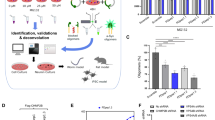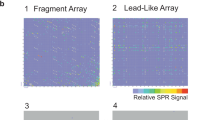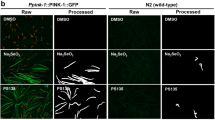Abstract
Protein misfolding and aggregation are common pathological features of several human diseases, including Alzheimer’s disease and type 2 diabetes. Here, we report an integrated and generalizable bacterial system for the facile discovery of chemical rescuers of disease-associated protein misfolding. In this system, large combinatorial libraries of macrocyclic molecules are biosynthesized in Escherichia coli cells and simultaneously screened for their ability to rescue pathogenic protein misfolding and aggregation using a flow cytometric assay. We demonstrate the effectiveness of this approach by identifying drug-like, head-to-tail cyclic peptides that modulate the aggregation of the Alzheimer’s disease-associated amyloid β peptide. Biochemical, biophysical and biological assays using isolated amyloid β peptide, primary neurons and various established Alzheimer’s disease nematode models showed that the selected macrocycles potently inhibit the formation of neurotoxic amyloid β peptide aggregates. We also applied the system to the identification of misfolding rescuers of mutant Cu/Zn superoxide dismutase—an enzyme linked with inherited forms of amyotrophic lateral sclerosis. Overall, the system enables the identification of molecules with therapeutic potential for rescuing the misfolding of disease-associated polypeptides.
This is a preview of subscription content, access via your institution
Access options
Access Nature and 54 other Nature Portfolio journals
Get Nature+, our best-value online-access subscription
$29.99 / 30 days
cancel any time
Subscribe to this journal
Receive 12 digital issues and online access to articles
$99.00 per year
only $8.25 per issue
Buy this article
- Purchase on Springer Link
- Instant access to full article PDF
Prices may be subject to local taxes which are calculated during checkout







Similar content being viewed by others
Change history
02 January 2018
In the version of this Article originally published, in Fig. 1c–e, on the x axes, the lines labelled ‘Aβ42’ and ‘Aβ42(F19S;L34P)’ grouped the data incorrectly; the line labelled Aβ42 should have grouped the data for Random 1–2 and Clones 1–10, and the line labelled Aβ42(F19S;L34P) should have only grouped the data for Random 1–2 on the right end of the plots and blots. These figures have now been corrected in all versions of the Article.
References
Chiti, F. & Dobson, C. M. Protein misfolding, functional amyloid, and human disease. Annu. Rev. Biochem. 75, 333–366 (2006).
Gavrin, L. K., Denny, R. A. & Saiah, E. Small molecules that target protein misfolding. J. Med. Chem. 55, 10823–10843 (2012).
Soto, C. et al. β-sheet breaker peptides inhibit fibrillogenesis in a rat brain model of amyloidosis: implications for Alzheimer’s therapy. Nat. Med. 4, 822–826 (1998).
Ma, K., Thomason, L. A. M. & McLaurin, J. Scyllo-inositol, preclinical, and clinical data for Alzheimer’s disease. Adv. Pharmacol. 64, 177–212 (2012).
Gervais, F. et al. Targeting soluble Aβ peptide with Tramiprosate for the treatment of brain amyloidosis. Neurobiol. Aging 28, 537–547 (2007).
Necula, M. et al. Methylene blue inhibits amyloid Aβ oligomerization by promoting fibrillization. Biochemistry 46, 8850–8860 (2007).
Habchi, J. et al. An anticancer drug suppresses the primary nucleation reaction that initiates the production of the toxic Aβ42 aggregates linked with Alzheimer’s disease. Sci. Adv. 2, e1501244 (2016).
Bodles, A. M., El-Agnaf, O. M., Greer, B., Guthrie, D. J. & Irvine, G. B. Inhibition of fibril formation and toxicity of a fragment of α-synuclein by an N-methylated peptide analogue. Neurosci. Lett. 359, 89–93 (2004).
Hu, Q. et al. Baicalein inhibits α-synuclein oligomer formation and prevents progression of α-synuclein accumulation in a rotenone mouse model of Parkinson’s disease. Biochim. Biophys. Acta 1862, 1883–1890 (2016).
Ehrnhoefer, D. E. et al. EGCG redirects amyloidogenic polypeptides into unstructured, off-pathway oligomers. Nat. Struct. Mol. Biol. 15, 558–566 (2008).
Coelho, T. et al. Mechanism of action and clinical application of tafamidis in hereditary transthyretin amyloidosis. Neurol. Ther. 5, 1–25 (2016).
Boeckler, F. M. et al. Targeted rescue of a destabilized mutant of p53 by an in silico screened drug. Proc. Natl Acad. Sci. USA 105, 10360–10365 (2008).
Sievers, S. A. et al. Structure-based design of non-natural amino-acid inhibitors of amyloid fibril formation. Nature 475, 96–100 (2011).
Nagai, Y. et al. Inhibition of polyglutamine protein aggregation and cell death by novel peptides identified by phage display screening. J. Biol. Chem. 275, 10437–10442 (2000).
Josephson, K., Ricardo, A. & Szostak, J. W. mRNA display: from basic principles to macrocycle drug discovery. Drug Discov. Today 19, 388–399 (2014).
Eisenberg, D.S. & Sawaya, M.R. Structural studies of amyloid proteins at the molecular level. Annu. Rev. Biochem. 86, 69–95 (2017).
Saunders, J. C. et al. An in vivo platform for identifying inhibitors of protein aggregation. Nat. Chem. Biol. 12, 94–101 (2016).
Kim, W. et al. A high-throughput screen for compounds that inhibit aggregation of the Alzheimer’s peptide. ACS Chem. Biol. 1, 461–469 (2006).
Zhang, X. et al. A potent small molecule inhibits polyglutamine aggregation in Huntington’s disease neurons and suppresses neurodegeneration in vivo. Proc. Natl Acad. Sci. USA 102, 892–897 (2005).
Kritzer, J. A. et al. Rapid selection of cyclic peptides that reduce alpha-synuclein toxicity in yeast and animal models. Nat. Chem. Biol. 5, 655–663 (2009).
Tardiff, D. F. et al. Yeast reveal a “druggable” Rsp5/Nedd4 network that ameliorates α-synuclein toxicity in neurons. Science 342, 979–983 (2013).
Lee, L. L. et al. Discovery of amyloid-beta aggregation inhibitors using an engineered assay for intracellular protein folding and solubility. Protein Sci. 18, 277–286 (2009).
Neumann, H. & Neumann-Staubitz, P. Synthetic biology approaches in drug discovery and pharmaceutical biotechnology. Appl. Microbiol. Biotechnol. 87, 75–86 (2010).
Craik, D. J. Seamless proteins tie up their loose ends. Science 311, 1563–1564 (2006).
Scott, C. P., Abel-Santos, E., Wall, M., Wahnon, D. C. & Benkovic, S. J. Production of cyclic peptides and proteins in vivo. Proc. Natl Acad. Sci. USA 96, 13638–13643 (1999).
Scott, C. P., Abel-Santos, E., Jones, A. D. & Benkovic, S. J. Structural requirements for the biosynthesis of backbone cyclic peptide libraries. Chem. Biol. 8, 801–815 (2001).
Paulus, H. Protein splicing and related forms of protein autoprocessing. Annu. Rev. Biochem. 69, 447–496 (2000).
Wurth, C., Guimard, N. K. & Hecht, M. H. Mutations that reduce aggregation of the Alzheimer’s Aβ42 peptide: an unbiased search for the sequence determinants of Aβ amyloidogenesis. J. Mol. Biol. 319, 1279–1290 (2002).
De Groot, N. S. & Ventura, S. Protein activity in bacterial inclusion bodies correlates with predicted aggregation rates. J. Biotechnol. 125, 110–113 (2006).
Levine, H. Thioflavine T interaction with synthetic Alzheimer’s disease beta-amyloid peptides: detection of amyloid aggregation in solution. Protein Sci. 2, 404–410 (1993).
Vandersteen, A. et al. Molecular plasticity regulates oligomerization and cytotoxicity of the multipeptide-length amyloid-β peptide pool. J. Biol. Chem. 287, 36732–36743 (2012).
Ahmed, M. et al. Structural conversion of neurotoxic amyloid-β1–42 oligomers to fibrils. Nat. Struct. Mol. Biol. 17, 561–567 (2010).
Walsh, D. M. et al. Naturally secreted oligomers of amyloid β protein potently inhibit hippocampal long-term potentiation in vivo. Nature 416, 535–539 (2002).
Jin, S. et al. Amyloid-β(1–42) aggregation initiates its cellular uptake and cytotoxicity. J. Biol. Chem. 291, 19590–19606 (2016).
De Felice, F. G. et al. Aβ oligomers induce neuronal oxidative stress through an N-methyl-D-aspartate receptor-dependent mechanism that is blocked by the Alzheimer drug memantine. J. Biol. Chem. 282, 11590–11601 (2007).
De Felice, F. G. et al. Alzheimer’s disease-type neuronal tau hyperphosphorylation induced by Aβ oligomers. Neurobiol. Aging 29, 1334–1347 (2008).
Alexander, A. G., Marfil, V. & Li, C. Use of Caenorhabditis elegans as a model to study Alzheimer’s disease and other neurodegenerative diseases. Front. Genet. 5, 279 (2014).
Lührs, T. et al. 3D structure of Alzheimer’s amyloid-β(1-42) fibrils. Proc. Natl Acad. Sci. USA 102, 17342–17347 (2005).
Waldo, G. S., Standish, B. M., Berendzen, J. & Terwilliger, T. C. Rapid protein-folding assay using green fluorescent protein. Nat. Βiotechnol. 17, 691–695 (1999).
Valentine, J. S., Doucette, P. A. & Zittin Potter, S. Copper-zinc superoxide dismutase and amyotrophic lateral sclerosis. Annu. Rev. Biochem. 74, 563–593 (2005).
Münch, C. & Bertolotti, A. Exposure of hydrophobic surfaces initiates aggregation of diverse ALS-causing superoxide dismutase-1 mutants. J. Mol. Biol. 399, 512–525 (2010).
Packer, M. S. & Liu, D. R. Methods for the directed evolution of proteins. Nat. Rev. Genet. 16, 379–394 (2015).
Wright, G. S., Antonyuk, S. V., Kershaw, N. M., Strange, R. W. & Samar Hasnain, S. Ligand binding and aggregation of pathogenic SOD1. Nat. Commun. 4, 1758 (2013).
Soragni, A. et al. A designed inhibitor of p53 aggregation rescues p53 tumor suppression in ovarian carcinomas. Cancer Cell 29, 90–103 (2016).
Frost, J. R., Jacob, N. T., Papa, L. J., Owens, A. E. & Fasan, R. Ribosomal synthesis of macrocyclic peptides in vitro and in vivo mediated by genetically encoded aminothiol unnatural amino acids. ACS Chem. Biol. 10, 1805–1816 (2015).
Bionda, N. & Fasan, R. Ribosomal synthesis of natural‐product‐like bicyclic peptides in Escherichia coli. ChemBioChem 16, 2011–2016 (2015).
Maksimov, M. O., Pelczer, I. & Link, A. J. Precursor-centric genome-mining approach for lasso peptide discovery. Proc. Natl Acad. Sci. USA 109, 15223–15228 (2012).
Austin, J., Wang, W., Puttamadappa, S., Shekhtman, A. & Camarero, J. A. Biosynthesis and biological screening of a genetically encoded library based on the cyclotide MCoTI‐I. ChemBioChem 10, 2663–2670 (2009).
Arnison, P. G. et al. Ribosomally synthesized and post-translationally modified peptide natural products: overview and recommendations for a universal nomenclature. Nat. Prod. Rep. 30, 108–160 (2013).
Liu, C. C. & Schultz, P. G. Adding new chemistries to the genetic code. Annu. Rev. Biochem. 79, 413–444 (2010).
Young, T. S. et al. Evolution of cyclic peptide protease inhibitors. Proc. Natl Acad. Sci. USA 108, 11052–11056 (2011).
Driggers, E. M., Hale, S. P., Lee, J. & Terrett, N. K. The exploration of macrocycles for drug discovery—an underexploited structural class. Nat. Rev. Drug Discov. 7, 608–624 (2008).
Broersen, K. et al. A standardized and biocompatible preparation of aggregate-free amyloid beta peptide for biophysical and biological studies of Alzheimer’s disease. Protein Eng. Des. Sel. 24, 743–750 (2011).
Brewer, G. J. & Torricelli, J. R. Isolation and culture of adult neurons and neurospheres. Nat. Protoc. 2, 1490–1498 (2007).
Friedman, W. et al. Differential actions of neurotrophins in the locus coeruleus and basal forebrain. Exp. Neurol. 119, 72–78 (1993).
Dietrich, P., Rideout, H. J., Wang, Q. & Stefanis, L. Lack of p53 delays apoptosis, but increases ubiquitinated inclusions, in proteasomal inhibitor-treated cultured cortical neurons. Mol. Cell. Neurosci. 24, 430–441 (2003).
Link, C. D. Expression of human beta-amyloid peptide in transgenic Caenorhabditis elegans. Proc. Natl Acad. Sci. USA 92, 9368–9372 (1995).
Drake, J., Link, C. D. & Butterfield, D. A. Oxidative stress precedes fibrillar deposition of Alzheimer’s disease amyloid β-peptide (1–42) in a transgenic Caenorhabditis elegans model. Neurobiol. Aging 24, 415–420 (2003).
Trott, O. & Olson, A. J. AutoDock Vina: improving the speed and accuracy of docking with a new scoring function, efficient optimization, and multithreading. J. Comput. Chem. 31, 455–461 (2010).
Morris, G. M. et al. AutoDock4 and AutoDockTools4: automated docking with selective receptor flexibility. J. Comput. Chem. 30, 2785–2791 (2009).
Sanner, M. F. Python: a programming language for software integration and development. J. Mol. Graph. Model. 17, 57–61 (1999).
Case, D. A. et al. AMBER 12 http://www.ambermd.org (Univ. California, San Francisco, CA, 2012).
Hornak, V. et al. Comparison of multiple Amber force fields and development of improved protein backbone parameters. Proteins 65, 712–725 (2006).
Hou, T. J., Wang, J. M., Li, Y. Y. & Wang, W. Assessing the performance of the MM/PBSA and MM/GBSA methods. 1. The accuracy of binding free energy calculations based on molecular dynamics simulations. J. Chem. Inf. Model. 51, 69–82 (2011).
Genheden, S. & Ryde, U. The MM/PBSA and MM/GBSA methods to estimate ligand-binding affinities. Expert Opin. Drug Dis. 10, 449–461 (2015).
Acknowledgements
The authors thank S. Benkovic (Penn State University) and M. H. Hecht (Princeton University) for the plasmids, D. Walsh (Brigham and Women’s Hospital), L. Stefanis (University of Athens) and M. Paravatou-Petsotas (National Center for Scientific Research 'Demokritos') for the cell lines, C. D. Link (University of Colorado Boulder) for the C. elegans CL2331 strain and P. Mehta (Institute for Basic Research in Developmental Disabilities) for the antibodies. The nematode strains used in this study were provided by the Caenorhabditis Genetics Center, supported by the United States National Institutes of Health National Center for Research Resources. We also thank D. Gialama for technical assistance with the initial expression vector construction and E. Megalou for bacterial sample preparations for the C. elegans feeding assays. We gratefully acknowledge G. Georgiou (University of Texas at Austin) for facilitating the flow cytometric sorting experiments and V. Papadimitriou and A. Xenakis for the dynamic light scattering experiments. This work was funded by the following projects: NEUROTHERAPY in the framework of the research grant 'Aristeia', financed by the Hellenic General Secretariat of Research and Technology and the National Strategic Reference Framework (to G.S.); CYCLIPAD in the framework of the research grant 'Thalis', financed by the Hellenic Ministry of Education, Research and Religious Affairs and the National Strategic Reference Framework (to E.S.G., G.S., F.N.K., M.P., M.M. and S.E.); the John S. Latsis Public Benefit Foundation (to N.C. and G.S.); and the Synthetic Biology research infrastructure OMIC-ENGINE, financed by the Hellenic General Secretariat of Research and Technology and the National Strategic Reference Framework. S.B. and Z.I.L. are recipients of fellowships for post-doctoral research by the Hellenic State Scholarships Foundation "IKY Fellowships of Excellence for Postgraduate Studies in Greece - Siemens Program". The Graphics Processing Unit (GPU)-accelerated molecular dynamics simulations were performed at the LinkSCEEM Cy-Tera GPU cluster, supported by the LinkSCEEM-2 project and funded by the European Union FP7 Capacities Research Infrastructure, INFRA-2010-1.2.3 Virtual Research Communities (grant agreement RI-261600). The molecular mechanics Poisson–Boltzmann surface area calculations were supported by computational time granted by the Greek Research and Technology Network in the National High Performance Computing Facility Advanced Research Information System under project identification pr001017.
Author information
Authors and Affiliations
Contributions
G.S. conceived and coordinated the project. G.S., N.C., M.P., K.D.P. and S.E. designed the research. G.S., E.S.G., M.P., S.E., M.M., K.V., N.C. and F.N.K. attracted funding. I.M., D.C.D., B.M., N.P., S.P., S.B., K.D.P., Z.I.L., A.V.S., N.B., K.V. and G.S. performed the research. I.M., D.C.D., B.M., N.P., S.P., S.B., K.D.P., Z.I.L., K.V., S.E., M.P., N.C. and G.S. analysed the data. G.S., N.C., M.P., Ν.Β., K.V., S.E. and M.G.P. supervised the research. G.S. wrote the paper with contributions from I.M., D.C.D., B.M., N.P., S.P., K.D.P., Z.I.L., S.E., N.C. and M.P. All authors read and approved the final version of the paper.
Corresponding author
Ethics declarations
Competing interests
G.S. is the inventor on patent applications for AβC5-34, AβC5-116, SOD1C5-4 and other Aβ- and SOD1-targeting peptide macrocyclic sequences described in this article.
Additional information
Publisher’s note: Springer Nature remains neutral with regard to jurisdictional claims in published maps and institutional affiliations.
A correction to this article is available online at https://doi.org/10.1038/s41551-017-0164-z.
Electronic supplementary material
Supplementary Information
Supplementary figures and tables
Rights and permissions
About this article
Cite this article
Matis, I., Delivoria, D.C., Mavroidi, B. et al. An integrated bacterial system for the discovery of chemical rescuers of disease-associated protein misfolding. Nat Biomed Eng 1, 838–852 (2017). https://doi.org/10.1038/s41551-017-0144-3
Received:
Accepted:
Published:
Issue Date:
DOI: https://doi.org/10.1038/s41551-017-0144-3
This article is cited by
-
Rationally designed cyclic peptides and nanomaterials as ‘next-generation’ anti-amyloid therapeutics
Journal of Materials Science (2023)
-
Identifying rescuers of misfolding
Nature Biomedical Engineering (2017)



